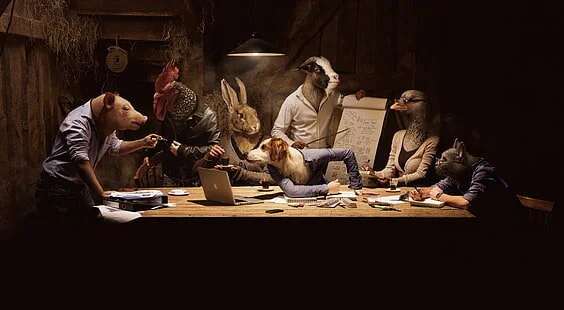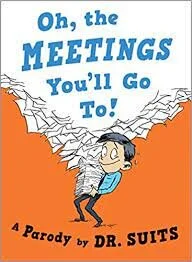Meetings, and Meetings, and Meetings…Oh My!
Tele-working and Working From Home (WFH) have always been a thing. I’ve actually worked from home since early 2006 and more and companies are choosing this as the new normal. The pandemic showed many business owners that physical location doesn’t always positively correlate to job performance or efficiency.
However, most of the businesses I talk to have forgotten one CRUCIAL step when upgrading to a remote/non-location-based organization.
That step is to analyze and scrutinize ALL recurring meetings
to determine their feasibility, relevancy, and need.
You MUST have a conversation with your team, superior(s), subordinate(s), etc. to determine where, when, how, and, most importantly, why to have your meetings. I call them “Meeting Audits.” If you’ve already done this, I suggest you do it again for every standing meeting you have in a week/month (and continue to reiterate at least 2x a year).
If you haven’t done this yet, you are not too late! There is no time like the present to help your team have more time in the present.
If you think having a meeting about your meetings is a waste of time, then I challenge you to answer these questions:
Are suffering from a severe case of “meeting fatigue?”
Do you have more meetings than space in your day to actually do the work?
Have you left a meeting in the last 10-days saying, “I’m never getting that time back” or “I have no idea why I was in that meeting?”
Do only half of your meeting attendees actually join on a regular basis?
Are your 1-on-1’s regularly canceled or ignored?
If the answer is yes to any of the above, then you need a Meeting Audit. Do not leave this to chance and do not leave this for “someone else to do.” I can assure you that nothing will change if so. Also, do not just accept what has been “done in the past.” So often, we continue behaviors solely because we’re too lazy, scared, or disinterested to change them. Henry Ford said it perfectly when he said:
“If you always do what you’ve always done, you’ll always get what you’ve always got.”
What to confirm in a meeting audit.
The purpose: You knew I was going to start with this, didn’t you? WHY are you having this meeting? What is its purpose and is that purpose still relevant? What makes this meeting a success? What outcomes are we expecting? What does completion look like?
The host: Who owns this meeting? The host is responsible for sending out meeting invitations, monitoring attendance, creating or coordinating the agenda, initiating the meeting on the chosen platform (see below), and ensuring all purposes and outcomes are met. They are also responsible for adhering to the agenda, keeping everyone on task, and minimizing tangents <- not a small task. I would recommend the “host” be someone with attention to detail, a caring and unselfish demeanor, and someone who has skin in the game.
The “star” of the meeting isn’t always the “host” so make sure you understand the difference.
The frequency: Does this meeting need to happen daily, weekly, monthly, or as needed? Keep in mind, there is no right answer...however, I would suggest a minimum of 1x a week for any team, Executive and Assistant Duo/Trio, and/or those with Direct Reports.
Regular meetings help businesses move forward. Period. Canceling meetings sends a message that the other person/people are not needed to help the business move forward…and they will eventually act as such.
The pace: Are there sections or breaks that you can delineate to keep the pace moving? If multiple people are talking, how much time do each of them have, and in what order do they speak? Do you want to engage in small talk before you get into the depths of a meeting, or do you want to avoid the chit-chat and get right to business? Some meetings might be more successful if there is a human or personal element at the beginning, and some not.
The length: Do they still need to be an hour-long? Or was that to allow an extra 15-minutes for everyone to get coffee and settle in the room when you were in person? Can you figure out a way to cut your meeting time in half? (HINT: Agendas, Agendas, Agendas). Much of this can be determined by…
The time: Don’t even get me started on people who show up late for scheduled meetings. There is nothing quite as rude or insulting as telling someone “My time is waaaaaaaay more important than yours,” which is exactly what being late is communicating. So, determine what time the meeting will start, find an agreement, and then start it on time, every time. If your people are late, it is their responsibility to find out what they missed. Don’t punish those who were present by repeating the entire first 10-minutes of the meeting for that one impolite team member.
Time is an exact, ladies and gentlemen. It’s non-negotiable. It is literal, precise, and faultless. 1:00pm means 1:00pm, not 1:08pm, not 1:10pm. There is nothing quite as awkward as staring at yourself on a video screen for 10-minutes waiting for someone else to grace you with their presence.
Did I mention that being late is incredibly rude?
Side Note: As the day progresses, we get decision fatigue and our brains are more tired. So plan to do your hardest work in the AM or most productive time and leave the afternoons for free-flowing thought, conversations of possibilities, etc.
The headcount: Does EVERYONE who was in this meeting before still need to be there? Frankly, don’t involve people who don’t care or who will not help move your project forward. Inviting people for political reasons is rarely worth the headache.
I also recommend filling your meeting with human opposites. Having a room full of the same type of person will usually result in stale, uncreative, unimaginative, and habitual answers/outcomes. Having a room full of people with different perspectives, different backgrounds, and different talents will ensure your outcome is unique, innovative, and diverse.
The platform: Is this regularly going to happen via phone, Zoom, MS Teams, Facetime, WhatsApp, etc.? I highly encourage all meetings to include video, when possible. The benefit of seeing each other visually goes way beyond relationship building and familiarization...it actually helps us understand each other better! Non-verbal communication accounts for 55% of our perception of what was said, so if you’re hoping to onboard your team to your cause, looking at them in their faces will exponentially help.
Within the platform, how will the included features be used? Are we using the chat? Are we raising our hands if we have questions? Are we recording?
Also if possible, use the same room or link each time so if someone “can’t find the link” they can look back at previous meetings for the information they need.
The next steps: What happens at the end of every meeting? Are tasks summarized so there are no misunderstandings? Are to-do lists created and sent out by someone (and whom?) Are decisions made or is this a conversation of possibilities? Is the agenda for the next meeting discussed? How are the meetings concluded?
The “what-if’s:” Determine what happens if the meeting host is sick or unavailable. Does the meeting still continue and who is the proxy?
Determine what happens if a weekly meeting isn’t needed that week...who and how is that decision made and how is that communicated to the rest of the participants. What is the determining factor to whether you have the meeting or not?
Determine what happens if signals drop or if the internet is choppy. Is a phone call the next step and who calls whom?
Determine the plan to add in “outsiders?” Who invites them and how is the content and context of the meeting provided to this person? Do all meeting attendees need to agree on who comes in? Do all meeting attendees need to know who is coming in?
And so…
Meetings are SUPPOSED to be helpful, specific, productive, and the springboard for decision making. Instead, these days, I’ve heard meetings referred to as, “jail,” “a waste of time,” or “worse than the dentist.” By spending an hour intentionally designing your meetings, you will save time, energy, and a whole bunch of Tylenol.


